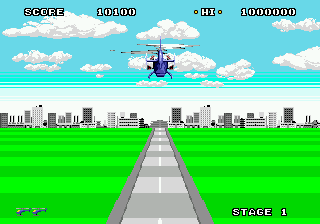Retro Replay Review
Gameplay
Super Thunder Blade keeps the core action of its arcade predecessor intact, immersing players in high-speed helicopter combat from both a behind-the-chopper and an overhead vantage point. The game’s four stages each begin in a dynamic third-person view, where you must juggle precision flying with rapid-fire shooting. Dodging incoming enemy fire, weaving between buildings or caves, and lining up the cannon and missiles for maximum impact delivers a constant adrenaline rush.
Between these aerial dogfights, you’ll encounter one or two smaller bosses that test your ability to adapt on the fly. These mid-stage opponents introduce new attack patterns—some lock onto your helicopter, while others barrage you with a hail of projectiles—forcing you to vary your approach rather than relying on a single strategy. Learning each boss’s behavior and timing your evasive maneuvers becomes an engaging puzzle in itself.
Once you clear the initial segment of a level, Super Thunder Blade switches to an overhead perspective for the climactic end-boss battle. This transition adds fresh challenge by shifting your spatial awareness: no longer dodging obstacles from behind, you now spiral around massive adversaries, targeting weak points while avoiding swirl attacks. The dynamic between the two viewpoints keeps gameplay from growing stale, yet the rapid shifts can sometimes feel jarring if you’re unprepared.
Difficulty ramps up quickly, making each new stage a gauntlet of tight corridors, surprise ambushes, and relentless boss patterns. While seasoned arcade fans will appreciate the throwback challenge, newcomers might hit several frustrating restarts before mastering the timing and positioning required. Still, once you learn the ropes, the game rewards precision and memorization with satisfying blowouts of on-screen enemies.
Graphics
Visually, Super Thunder Blade showcases the Sega Genesis’s attempt at pseudo-3D effects alongside classic sprite work. The behind-the-helicopter segments employ scaling backgrounds and sprite scaling to simulate depth, giving you a genuine sense of speed as distant objects rush toward you. Buildings crumple convincingly under the force of your missiles, and explosions bloom with satisfying heft.
Switching to the overhead perspective reveals a crisper, more grid-like field where your chopper and enemy units are rendered in clean, colorful sprites. Although the change in viewpoint can reduce the sense of immersion, it emphasizes strategic movement—dodging homing rockets and weaving through narrow passages feels markedly different here, and the sharper visuals help you anticipate threats more clearly.
That said, the game’s ambition sometimes outpaces the hardware. Frame rate dips occur when multiple explosions or projectiles flood the screen, leading to brief stutters that can throw off your timing. Texture repetition in the backgrounds also becomes noticeable over the four stages, making certain corridors and caverns feel a bit too familiar after a few playthroughs.
Despite these shortcomings, the overall presentation remains impressive for its era. The color palette is vibrant, enemy designs are varied, and the perspective shifts are handled with technical flair. Super Thunder Blade succeeds in delivering a visual showcase that feels both nostalgic and technically competent on the Genesis platform.
Story
Super Thunder Blade doesn’t waste time with elaborate cutscenes or character arcs—its narrative is a straightforward setup to justify the onslaught of aerial warfare. You assume command of an advanced combat helicopter tasked with repelling an unnamed enemy force threatening global stability. It’s the kind of bare-bones premise common in ‘80s and ‘90s action games, and it serves its purpose without getting in the way.
While there are no in-depth dialogues or branching plotlines, each stage’s distinct environments—from urban sprawl to subterranean caverns—hint at a larger world under siege. The barebones storytelling leaves room for the player’s imagination to fill in gaps: are we rescuing hostages, halting a coup, or thwarting an alien incursion? That ambiguity can be surprisingly liberating, letting the explosive action take center stage.
Boss designs occasionally come with brief onscreen titles or one-line taunts, offering a sliver of personality to break up the relentless action. These small touches give each end-of-stage confrontation a bit of narrative flavor without bogging down the fast-paced flow. If you’re seeking a rich, character-driven tale, you’ll find this approach sparse—but if you simply want wings-level aerial combat, it keeps the focus where it belongs.
Overall, the story framework in Super Thunder Blade is serviceable rather than memorable. It provides just enough context to justify your helicopter’s mission but leaves the deeper motivations and world-building to your own imagination. For many players, that’s more than sufficient to stay engaged with the game’s core thrills.
Overall Experience
Super Thunder Blade stands as a compelling arcade-style shooter on the Genesis, delivering high-octane helicopter combat across two distinct gameplay perspectives. Its blend of behind-the-chopper dogfighting and overhead boss encounters ensures variety, while the straightforward controls make it accessible even to newcomers. The brisk pace and steep difficulty curve create that classic “just one more try” appeal that defines the genre.
However, the game isn’t without its flaws. Performance hiccups can disrupt tight maneuvers, and the limited stage variety means you’ll see the same layouts after multiple passes. The story is pressed to the background, and if you’re looking for narrative depth or character development, you’ll likely be disappointed.
For fans of arcade shooters and retro enthusiasts seeking a dose of helicopter mayhem, Super Thunder Blade delivers an engaging, challenging experience that showcases the Genesis hardware. Its addictive combination of rapid-fire action, shifting perspectives, and relentless boss battles creates a satisfying loop that keeps you coming back. Just be prepared for some trial-and-error as you learn each stage’s patterns.
In the end, Super Thunder Blade is a worthy entry in the Thunder Blade lineage. It may not revolutionize the genre, but it faithfully captures the thrill of piloting a heavily armed helicopter through hostile territory. If you appreciate old-school difficulty and enjoy mastering challenging flight-based shooters, this game is well worth adding to your collection.
 Retro Replay Retro Replay gaming reviews, news, emulation, geek stuff and more!
Retro Replay Retro Replay gaming reviews, news, emulation, geek stuff and more!









Reviews
There are no reviews yet.